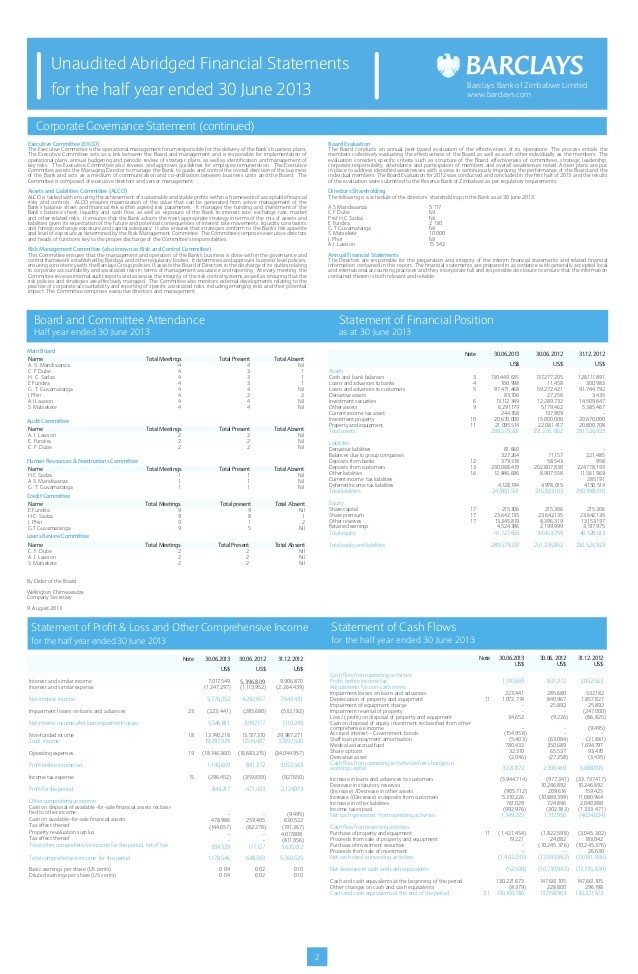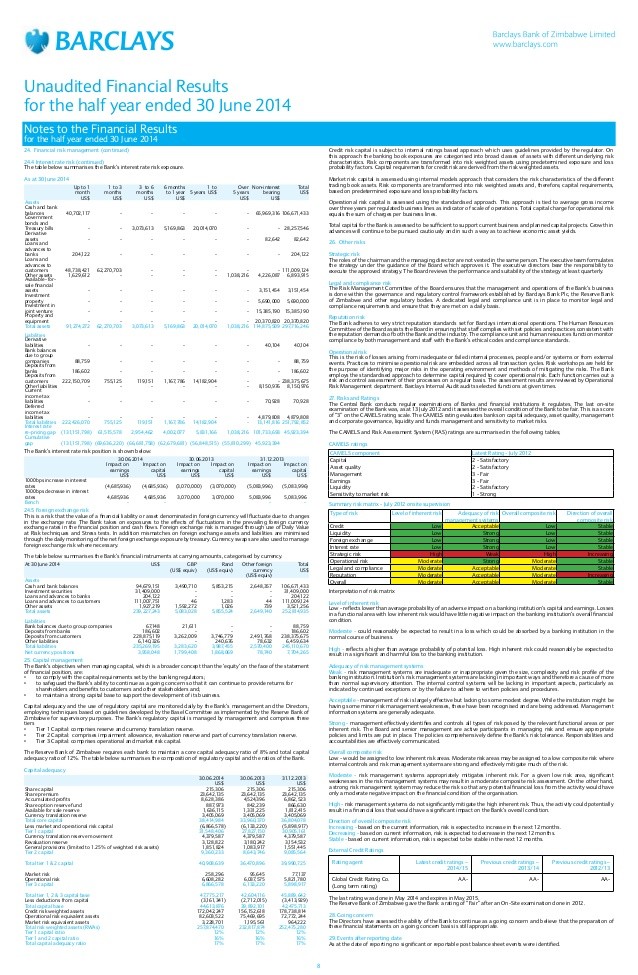Credit risk mitigation Barclays Annual Report 2012
Post on: 29 Июнь, 2015 No Comment

Navigation
What does being the
Strategic report
Bankers are overpaid and dont have societys interests at heart.
Governance
Its one scandal after another. How can I learn to trust Barclays again? Will the culture really change?
Risk review
As a shareholder, returns and performance have been disappointing. How will you change that?
Navigation
Barclays employs a range of techniques and strategies to actively mitigate credit risks to which it is exposed. These can broadly be divided into three types:
- netting and set-off;
- collateral; and
- risk transfer.
Barclays has detailed policies in place to ensure that credit risk mitigation is appropriately recognised and recorded. The recognition of credit risk mitigation is subject to a number of considerations, including ensuring legal certainty of enforceability and effectiveness, ensuring the valuation and liquidity of the collateral is adequately monitored, and ensuring the value of the collateral is not materially correlated with the credit quality of the obligor.
All three types of credit risk mitigation may be used by different areas of the Group for exposures with a full range of counterparties. For instance, Investment Bank, Corporate Banking and other business areas may all take property, cash or other physical assets as collateral for exposures to retailers, property companies or other client types.
Netting and set-off
In many jurisdictions in which Barclays operates, credit risk exposures can be reduced by applying netting and set-off. In exposure terms, this credit risk mitigation technique is used mainly in derivative and repo transactions with financial institutions.
For derivative transactions, Barclays will often seek to enter into standard master agreements with counterparties (e.g. ISDA). These master agreements allow for netting of credit risk exposure to a counterparty resulting from a derivative transaction against Barclays obligations to the counterparty in the event of default, to produce a lower net credit exposure. These agreements may also reduce settlement exposure (e.g. for foreign exchange transactions) by allowing for payments on the same day in the same currency to be set off against one another.
In the majority of its portfolios Barclays uses the Internal Model Method (IMM) to calculate counterparty credit risk exposures.
Collateral
The Group has the ability to call on collateral in the event of default of the borrower or other counterparty, comprising:
- Home loans. a fixed charge over residential property in the form of houses, flats and other dwellings;
- Wholesale lending. a fixed charge over commercial property and other physical assets, in various forms;
- Credit cards, unsecured and other retail lending: includes charges over motor vehicle and other physical assets; second lien charge over residential property, which is subordinate to first charge held either by the Group or by another party; and finance lease receivables, for which typically the Group retains legal title to the leased asset and has the right to repossess the asset on the default of the borrower;
- Derivatives: Barclays also often seeks to enter into CSAs with counterparties with which Barclays has master agreements in place. These annexes to master agreements provide a mechanism for further reducing credit risk, whereby collateral (margin) is posted on a regular basis (typically daily or weekly) to collateralise the mark to market exposure of a derivative portfolio;
- Reverse repurchase agreements: collateral typically comprises highly liquid securities which have been legally transferred to Barclays subject to an agreement to return them for a fixed price; and
- Financial guarantees and similar off-balance sheet commitments: cash collateral may be held against these arrangements.

In exposure terms, the main portfolios that Barclays takes collateral for are home loans and reverse repurchase agreements with financial institutions.
The Group may also obtain collateral in the form of floating charges over receivables and inventory of corporate and other business customers. The value of this collateral varies from period to period depending on the level of receivables and inventory. It is impracticable to provide an estimate of the amount (fair value or nominal value) of this collateral. The Group may in some cases obtain collateral and other credit enhancements at a counterparty level, which are not specific to a particular class of financial instrument. The fair value of the credit enhancement gained has been apportioned across the relevant asset classes.
Assets other than cash are subject to regular revaluation to ensure they continue to achieve appropriate mitigation of risk. Customer agreements often include requirements for provision of additional collateral should valuations decline or credit exposure increase (for example due to market moves impacting a derivative exposure).
The carrying value of non-cash collateral reflects the fair value of the physical assets limited to the carrying value of the asset where the exposure is over-collateralised. In certain cases where active markets or recent valuations of the assets are not available, estimates are used. For assets collateralised by residential or commercial property (and certain other physical assets), where it is not practicable to assess current market valuations of each underlying property, values reflect historical fair values updated for movements in appropriate external indices. For further information on loan-to-value ratios in principal home loans portfolios see the Retail credit risk section .
For assets collateralised by traded financial instruments, values reflect mark to market or mark to model values of those assets, applying a haircut where appropriate.
The net realisable value from a distressed sale of collateral obtained by the Group upon default or insolvency of a counterparty will in some cases be lower than the carrying value recognised above. Assets obtained are normally sold, generally at auction, or realised in an orderly manner for the maximum benefit of the Group, the borrower and the borrowers other creditors in accordance with the relevant insolvency regulations. For business customers, in some circumstances, where excess funds are available after repayment in full of the outstanding loan, they are offered to any other, lower ranked, secured lenders. Any additional funds are returned to the customer. Barclays does not, as a rule, occupy repossessed properties for its business use or use assets obtained in its operations.
When property is taken as collateral it is monitored to ensure that the current value is not less than its value at origination. Monitoring is undertaken at least once every three years for residential property, and annually for commercial property. More frequent monitoring is carried out where the property sector is subject to significant deterioration.
Deterioration is monitored principally by geography. Specific exercises to monitor property values may be undertaken where the property sector in a given geography has been subject to significant deterioration and where Barclays has a material concentration of property collateral.
Monitoring may be undertaken either at the level of an individual property or at a portfolio level. Monitoring on a portfolio level refers to a more frequent process of indexing collateral values on each individual loan, using a regional or national index, and updating LGD values. Where an appropriate local index is not available, property values are monitored on an individual basis as part of the annual review process for the loan.
For larger loans, property valuation is reviewed by an independent valuer at least every three years, and an independent valuer also reviews the property valuation where information indicates that the value of the property may have declined materially relative to general market prices. In addition, trigger points are defined under which property values must be reviewed.
Liens over fluctuating assets such as inventory and trade receivables, known as floating charges, over the assets of a borrower are monitored annually. The valuation of this type of collateral takes into account the ability to establish objectively a price or market value, the frequency with which the value can be obtained (including a professional appraisal or valuation), and the volatility or a proxy for the volatility of the value of the collateral.
Additional revaluations are usually performed when a loan is moved to EWL or WL. More detail of when a corporate account may be moved to an EWL or WL may be found in the Reporting section. Exceptions to this may be considered where it is clear a revaluation is not necessary, for instance where there is a very high margin of security or a recent valuation has been undertaken. Conversely, a material reduction in the value of collateral held represents an increase in credit risk and will often cause a loan to be placed on the EWL or WL.
Any one of these events may also trigger a test for impairment, depending on individual circumstances of the loan. When calculating impairment, the difference between an assets carrying amount and the present value of all estimated cash flows discounted at the original effective interest rate will be recognised as impairment. Such cash flows include the estimated fair value of the collateral which reflects the results of the monitoring and review of collateral values as detailed above and valuations undertaken as part of our impairment process.
Whether property values are updated as part of the annual review process, or by indexation of collateral values, the updated collateral values feed into the calculation of risk parameters (for example Loss Given Default) which, in turn, feed into identified and unidentified impairment calculations at each balance sheet date.
Trends in loan loss rates incorporate the impact of any decrease in the fair value of collateral held.
Where Barclays calculates regulatory capital under advanced IRB regulations the benefit of collateral is generally taken by adjusting LGDs. For standardised portfolios the benefit of collateral is taken using the financial collateral comprehensive method: supervisory volatility adjustments approach.
Risk transfer
A range of instruments including guarantees, credit insurance, credit derivatives and securitisation can be used to transfer credit risk from one counterparty to another. This mitigates credit risk in two main ways:
- firstly, if the risk is transferred to a counterparty which is more credit worthy than the original counterparty, then overall credit risk will have been reduced; and
- secondly, where recourse to the first counterparty remains, both counterparties must default before a loss materialises. This will be less likely than the default of either counterparty individually so credit risk is reduced.
Risk transfer can also be used to reduce risk concentrations within portfolios lowering the impact of stress events.
Risk transfer transactions are undertaken with consideration to whether the collateral provider is correlated with the exposure, the credit worthiness of the collateral provider and legal certainty of enforceability and effectiveness. Where credit risk mitigation is deemed to transfer credit risk this exposure is appropriately recorded against the credit risk mitigation provider.
The balances shown represent the notional value of the guarantees held by the Group issued by corporate and financial institutional counterparties. In addition, the Group obtains guarantees from customers in respect of personal loans and smaller business loans, which are not reflected in the above table.
In exposure terms, risk transfer is used most extensively as a credit risk mitigation technique for wholesale loans and derivative financial instruments.
For instruments that are deemed to transfer credit risk, in advanced IRB portfolios the protection is recognised by using the PD and LGD of the protection provider.
Off-balance sheet risk mitigation
The Group applies fundamentally the same risk management policies for off-balance sheet risks as it does for its on-balance sheet risks. In the case of commitments to lend, customers and counterparties will be subject to the same credit management policies as for loans and advances. Collateral may be sought depending on the strength of the counterparty and the nature of the transaction.
Previous
Derivative credit risk Back to top Next














